Canadian Debt:
Are Canadians struggling with debt?
There is an old, unwritten rule, that goes a little something like this “Don’t talk about your finances with anyone”. Some quotes like this are timeless but I think that this one has run its course. Canadian debt is becoming a serious problem that definitely requires more attention.
Financial education is something that should be widely accepted and embraced by all. According to CBC news, Millennial debt has shown a 12.3% increase since 2018 and sits around $515.9 billion dollars. To make matters even more concerning, its younger counterpart, Gen-X is hovering around $767.4 billion.
Now, this statistic does not happen to consider if this is “good debt” or “bad debt”, which we will cover later, but is still cause for concern. We must start asking ourselves serious questions about how we are spending our money, where we should we invest our money, and pursue a new standard that allows for more openness about our financial situations.
Canadian Debt: You are not alone
Do you feel like you are constantly running away from your credit card statement, mortgage payments, and utility bills? Truth be told, you are not alone. Consider these Canadian statistics for a moment:
- 94% of Canadians agree that the average household has to much debt (Manulife Bank Debt Survey)
- 84% state that getting out of financial debt is their number one priority
- 30% feel that they can’t do things they enjoy because of debt
- 67% of Canadians assume that others are also in debt
- 40% think that they will not become debt free in their life-time

Canadian Debt: Good debt versus bad debt
When we hear the word debt, usually the worst comes to mind. What if I were to tell you that debt can be broken down into two categories: good and bad? A survey with over 8000 respondents, conducted by our team at Caddle, indicated that 54% of our members are only slightly familiar with the concept of bad debt. That being said, let’s analyze the differences.
Good Debt
This form of debt involves taking out a loan or refinancing a property in order to use the equity to invest into something that will ultimately generate income. Good debt includes, but is not limited too, investing in your education, opening a small business, or real estate and homeownership. This type debt is two-fold because as you are making the payments for your loan you are developing a relationship with your financial institution and therefore, increasing the likelihood of getting a larger loan in the future.
Bad Debt
Bad debt is when you borrow money in order to purchase a product or service that will decrease in value instantaneously or over time. Some examples of bad debt include cars, jewellery, clothing, consumables, and credit cards. Not only is the product or service that you have purchased going to decrease immediately, but you will also have to pay interest on the amount spent.
Canadian Debt: Credit Card Debt
With Canadian’s debt statistics on an upward trajectory, it’s important to identify some of the key contributors. With low interest rates, low unemployment, and rising wages, it is uncommon for us to be experiencing this particular issue. The most common culprit when it comes to bad debt is the credit card. Average non-mortgage debt per Canadian citizen is predicted to hit $31,000 by the start of 2020.
Consequently, we are also seeing increases in Canadians carrying credit card balances, in the amount of $4,465 on average. Now, depending on your existing credit card provider you may be able to leverage the benefits and mitigate the risks. Most credit cards come with some sort of rewards incentive to differentiate themselves from the competition. You can make the most out of these rewards if you are diligent and pay your owing balance by the end of each billing cycle. Some of the common credit card benefits include:
- Cash back
- Travel rewards
- No annual fee
- Purchase insurance
- Travel insurance
If you are not aware of your credit card rewards system, go check right now! Most companies incentivize certain purchases such as gas, grocery, or pharmaceutical.
Canadian Debt: Saving Money
Saving is one of the those concepts that sounds and looks easy, but never works out the way you planned. For me, I decided to look back at one of my most recent financial statements and see what I am spending money on. I had over 5 different monthly subscriptions! Why am I paying for Crave, Netflix, and Amazon video? Whether it is our skin care products, coffee, food, streaming services, or web services, we often don’t realize how complacent we become with our spending habits. Let’s dive deeper and look at what Caddle members had to say about savings.
Canadian Debt: Saving... why is it so hard?
The following statistics are a representation of over 8000 Canadians opinions on financial debt and savings.
- Only 28% of members are likely to seek out information about saving money
- 23% state that the cost of living (goods and services) are the main reason why they can’t save money
- 21% state that their regular expenses restrict their ability to save money
- 27% are somewhat likely to consider using a financial savings app to help track and assist with their savings goals

Canadian Debt: Recommendations
Debt is something that can be conquered if you are willing to invest your time and become a diligent record keeper. It is important to utilize the available assets and never be afraid to ask questions. Often, people are intimidated by advisors and have preconceived notions about the amount of money required to begin saving and get out of debt. As someone who is currently working in the financial industry no amount is too little to begin saving. There is no better time than now to evaluate your financial future. Get started by using some of the tips provided below:
- Use the Caddle app to earn cash back and save on your monthly expenses, obviously 😉
- Use financial apps like Mylo in order to save the additional change on every purchase
- Talk to your financial advisor or do some window shopping (make sure you are getting the best services on the market)
- Ask questions about your credit card and rewards programs (check out this list: best credit card Canada)
- Look into debt consolidation if you owe money to multiple institutions
- Open a High Interest Savings Account (HISA), Tax Free Savings Account (TFSA), and a Registered Retirement Savings Plan (RRSP)
Good luck with your savings and remember to answer those surveys to help create awareness about topics that interest you. They can help promote product changes and influence brands to provide you with more of the services you desire.
More About Caddle
Thanks for reading our blog post! If this is your first time on our webpage you may be wondering who we are and what we do?
Caddle is a data insights company that has a passion for understanding market trends. This information is then translated to the market industry leaders for the benefit of understanding the buying behaviours of their consumers. We keep our finger on the pulse of Canadians with over 8000 daily survey respondents and 300,000 monthly app users. Contact us for more information and resources.
The Canadian Food Guide: No longer a prescription diet
The push towards a plant based diet
Canada’s Food Guide
We are constantly changing the way that we are eating. It could be because of something you read in a weight loss magazine, heard through the grapevine, or maybe even a new trending diet on Instagram. In today’s technological era it’s tough to determine what’s authentic and what’s just straight-up fake. One resource that you can trust has just presented us with a new guide to healthy living. Enter – the new and improved Canadian food guide!
It’s getting three cheers from some and eye rolls from others.
Canada’s Food Guide: So what has changed?
It is no surprise that the Canadian food guide has seen its fair share of changes since its publication in 1942. That being said, the guide has been in a 12-year hiatus and Canadians are eager to see what changes are being made.
The process has so far taken three years, with Health Canada hiring various market research companies to consult with more than 26,000 Canadians. Health Canada has also held briefing sessions with various health associations and industry groups. – CBC News
As Canadians, we rely on the national food guide to decrease the number of nutritional deficiencies and increase overall health. In the past, it has provided us with portions sizes, food groups, cooking tips, and scientific research. It helps us ensure that our loved ones live long and healthy lives. We can see that the updated guide is exploring a new direction that reinforces a vegetarian style diet (plant based) and kicks the food groups to the curb.
That being said, the food guide is a one size fits all approach. It may not be considering your personal deficiencies, body type, lifestyle choice(s), and you should use it as a reference when planning meals. The best course of action is to consult a nutritionist or specialist before making significant changes to your own diet.
Here are the changes that we have identified
- More focus on a plant-based diet(s)
- Dairy and meat are being pushed out
- No more four food groups
- Eat more fruits and vegetables
- No more portion sizes
- Increase your water consumption
- Food philosophy (eating together)
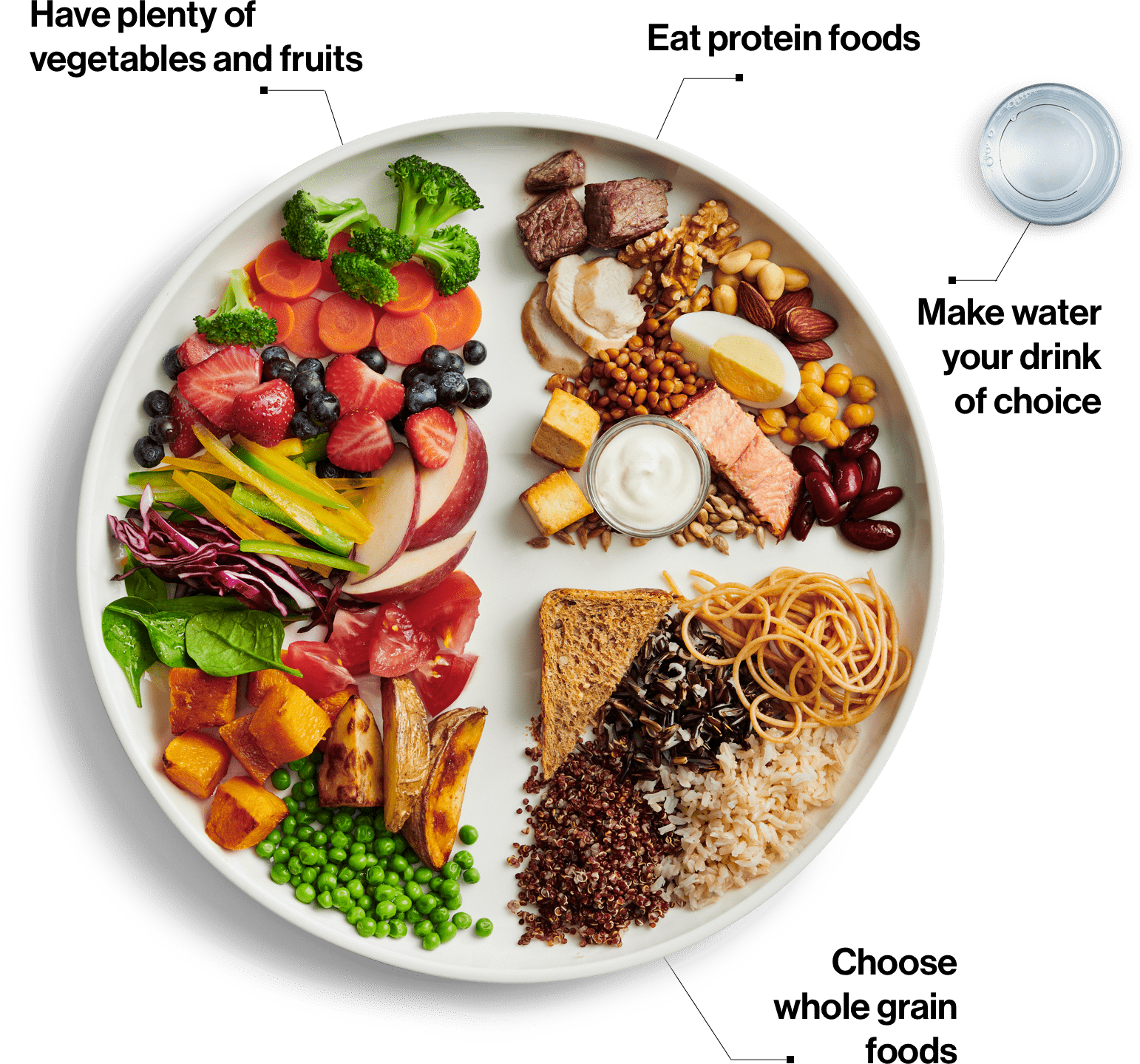
Canada’s Food Guide: Time to take action
The new food guide image conveys a simple message according to Health Canada: Eat a diet made up of roughly half fruits and vegetables, and half of the remaining two categories — easy as that.
“It doesn’t need to be complicated folks,” Petitpas Taylor said. “It just needs to be nutritious, and, might I dare say, fun.”
However, the overall simplicity of the new guide is still receiving mixed reviews and skepticism.
If we look back at the previous prescription approach it was unachievable and quite frankly, directed towards children (you remember the four food groups rainbow in elementary school). The new food guide has simplistic yet powerful imagery that encourages people to make realistic changes to live their best life.
We can now say goodbye to the recommendations to eat a specific number of serving sizes across each of the food groups. Gone is information about what makes up a serving size for different types of food. Let’s be honest, did you ever weigh, scale, and categorize your foods so that you ate the prescribed amount of food for each food group? Of course not, nobody has the time for that!
Dairy Products: So long milk, it was good while it lasted
Milk, for as long as we can remember, has always been a staple of the Canadian diet. Its nutritional benefits were linked to bone and dental health, diabetes prevention, and heart health.
As the times are changing we are entering a new era of healthy eating and health professionals are putting dairy under the microscope. Not just milk is under scrutiny, its the entire dairy category! That includes items such as cheese, cream, butter, yogurt, and ice cream, just to name a few.
Many people are disgruntled with the removal of dairy as an independent category. It has been placed into another category that we can agree may be less visual, but it’s still a part of the food guide. It has become a misconception that dairy is deemed “unhealthy”. Dairy products still offer a variety of different benefits but the traditional dosage or “3 pints per day” is just unnecessary. To follow suite, dairy consumption/sales have also been decreasing for the last 10 years according to the government of Canada.

Dairy Products: The alternatives are getting more attention
For those of you that love dairy you are in luck. A variety of alternatives are at your disposal that are extremely competitive with cows milk when it comes to nutrients, fats, and calcium. If you are intolerant and allergic to cows milk you can still consume some of the alternatives (almond milk). You may have already identified the significant changes happening in the United Kingdom. Non-dairy sales were three times bigger than dairy sales at Whole Foods Market in the UK this year (2019). This means that dairy is not completely disappearing but consumers are focusing their attention on many other alternative forms.
- Almond milk
- Soy milk
- Coconut milk
- Rice milk
- Oat milk
Depending on which alternative fits your lifestyle, you may be able to decrease costs by making it at home and, therefore, decrease damaging environmental impacts while maintaining sufficient nutrient intake.
Milk Nutrition: What are Caddle members saying about milk?
You spoke up about milk consumption and the changes to the Canadian food guide. The majority of our respondents were millennials (in their 30’s) and from Ontario. Here is what we gathered:
- Out of the 92% that consume dairy, 62% disagree with the new food guide
- Large percentage of the respondents had small children at home (increased milk consumption)
- 50% consume milk for the taste and 43% said that they consume milk for its nutritional value
- 73% of members said they didn’t consult anyone about their dairy consumption
Dairy Products: Decreased consumption comes at a price
Changes that have been made to the Canadian food guide have outraged dairy farmers and rightfully so. Milk has been removed as an independent category and grouped into proteins. With milk consumption decreasing in general, it’s worrisome for stakeholders in the dairy industry.
The Canadian government places significantly high tariffs on importing milk into Canada. This is preventative measure attempts to decrease the market saturation of American products and protect local dairy farmers.
“The Canadian dairy industry is a key driver of our national economy and represents one of the largest agri-food industries in the country,” said Wally Smith, President of Dairy Farmers of Canada.
Canada’s dairy industry brings in about 20 billion in GDP, 3 billion in tax contributions and over 200,000 full-time jobs. The question that we have to ask ourselves as consumers is, are we willing to ignore new research findings in order to support the dairy industry?
Did you say a Plant Based Diet?
Some of you are wondering, what is a plant based diet? Others might be thinking how can this diet be sustainable long term?
No, a plant based diet doesn’t mean that you have to go into your fridge or freezer right now and get rid of that steak or chicken.
It means that you should consciously prioritize fruits, vegetables, nuts, grains, legumes, beans, seeds, and oils. Aside from the array of health benefits that are associated with this diet it also comes with environmental sustainability.
When switching to a plant based diet it comes with a bit of homework. You need to understand what nutrients you receive from the foods you plan on giving up and ensure that you are receiving the equivalent in the foods you plan on consuming.
The best way to get started is just allocating one day of the week to strictly eat plant based foods. Following food guides or industry professionals online to get the best recipes and up to date information doesn’t hurt either. Check out the example!
Plant Based Diet Example:
Breakfast: Breakfast wrap with whole grain tortilla, scrambled egg(s), black beans, peppers, onions, and your choice of sauce.
Lunch: Mediterranean salad with fresh lettuce, cucumbers, chick peas, lentils, goat cheese, avocado, and dressing.
Dinner: Grilled veggie kabobs with green and red peppers, grilled tofu, spinach salad, and zucchini.
Canada’s Food Guide: What you should takeaway from the changes
Canada’s updated food guide has retired the traditional rainbow and four food groups in order to appeal to a wider audience. It has demoted meat and dairy by placing them into categories with a wider range of proteins.
The new food guide accurately reflects the existing research about human anatomy and healthy living, while limiting the biased input from special interest parities.
Some of the main reasons people are cutting milk are connected to the environment, health, and ethics (religious beliefs). If you want to keep milk as apart of your daily routine consider the array of different alternatives that offer great taste, nutritional benefits, and no environmental impact.
This food guide does not spoon feed you like it has in the past. It requires you to take action by showing you what your plate should look like when you sit down to have a meal. It is apart of Canadian culture to cook, talk, laugh, and eat together.
It’s time to put down the processed food that have become so accessible and convenient. We should give the new food guide a chance and see if it can have a positive impact on society and our wellbeing.
About Caddle
Thanks for reading our blog post! If this is your first time on our webpage you may be wondering who we are and what we do?
Caddle is a data insights company that has a passion for understanding market trends which can be translated to the market industry leaders for the benefit of understanding the buying behaviors of their consumers.
Click this link to find out more and earn some cash back from our surveys!
[simple-author-box]
How long does it take plastic to decompose – longer than you think
How long does it take plastic to decompose?
To be completely frank, that’s a difficult question. Modern plastic has really only been in production for about 50 years. But a lot of those plastics are still floating around the world today. The lifetime of single-use plastics varies from product to product, but this article aims to give a ballpark range for single-use products like plastic water bottles, plastic bags, and plastic straws.
What is plastic?
The first synthetic plastics were developed in early 1907. What gives plastic its strength and flexibility is the length of the molecule chains from the polymers that make plastic. The longer each chain of molecules, the stronger, more lightweight and flexible the plastic will be. When petroleum and fossil fuels were shown to produce longer chain polymers this then began the shift from natural to synthetic plastics.
Why is plastic bad?
Nowadays the majority of plastics used every day are made of polyethylene terephthalate (PET), which is a petroleum-based synthetic plastic.
What’s the harm in that you ask? Well, you know the stuff you put in your car that makes your car go? That’s made out of petroleum too and we all know how bad that is for the environment. So think about how bad that effects our landfills, oceans, and the world as a whole. Probably not the best remedy.
With most plastic being primarily petroleum-based for its strength, it also means that the majority of plastics won’t through biodegradation like natural products. Meaning it’s pretty damn tough to get rid of the stuff because it lives on this planet for quite some time.
How long does it take a plastic bottle to decompose?
No question about it, plastic is pretty bad and is made of some questionable materials that harm the planet. So, how long does this plastic stuff stick around for? Well, according to some researchers, they estimate that due to the PET used in objects like plastic bags, plastic water bottles and plastic straws, it could take upwards of 450 years to decompose.
Yep, a rather frightening estimation. Let’s break that down so it really hits home for you. Breaking that down is equivalent to 5,400 months, or 21,600 weeks, or 1,971,000 days just for one single plastic bottle to decompose. Now think about how many plastic water bottles are on this planet. Probably not so thirsty anymore now, are you? Check out some alternatives here.
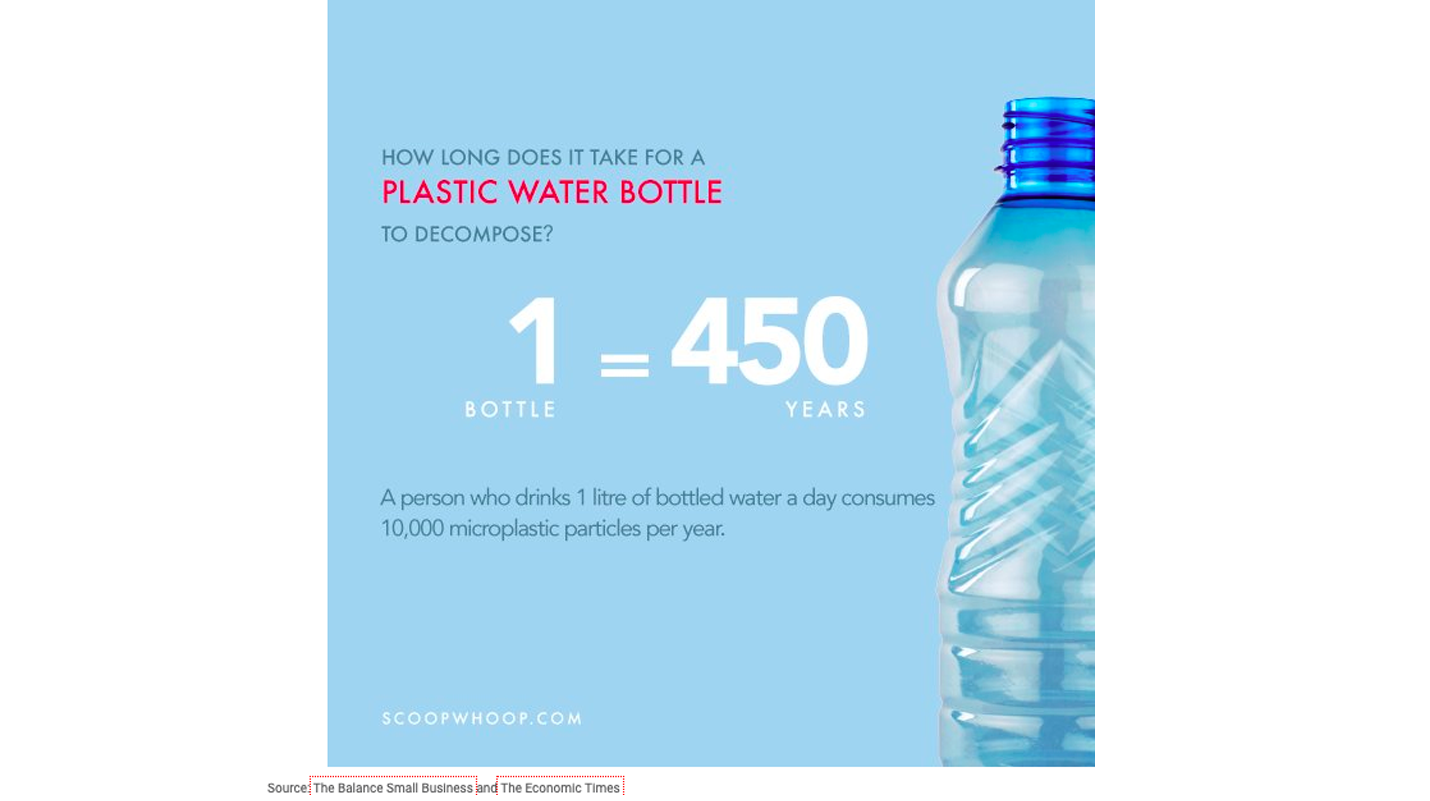
How long does it take a plastic bag to decompose?
So, what about plastic bags, how long do they take to decompose?
Answer: between 10 and 1,000 years.
This is a rather frustrating statistic. If it takes 1,000, that’s concerning. But if it takes only 10 years, that’s not so bad– is it?
Guess again. It all depends on how much ultraviolet radiation a plastic bag gets from the sun. If it’s baking in the sun, the bag could break down a lot sooner (i.e., 10 years) than a plastic bag that’s hidden from the sun (i.e., 1,000 years).
Even if it takes 10 years, this is still concerning. Polyethylene in plastic bags does not biodegrade. It simply becomes brittle, causing the bag to break down into tiny plastic pieces. In other words, there may not be a plastic bag floating in the wind or oceans. Instead, there are now tiny microplastics being scattered around the world.
To fix this, maybe it would be best to go back to paper bags for our shopping needs. The alternatives are endless. You can find more great, simple options here.

How long does it take a plastic straw to decompose?
What was once the most convenient tool is now going through a shift for being one of the most hated plastic products – plastic straws.
It will take approximately 200 years for a plastic straw to decompose. Much longer than the time they have been in modern existence.
So, what can we do? Well, continuing to throw our plastic straws into the garbage would be a step in the opposite direction since they’re not easily recyclable due to their size. For starters, I would suggest alternatives. There are always alternatives, like stainless steel, paper, or biodegradable straws. Better yet, don’t use a straw at all! or just go without a straw. Go cold turkey on the drinking apparatus!
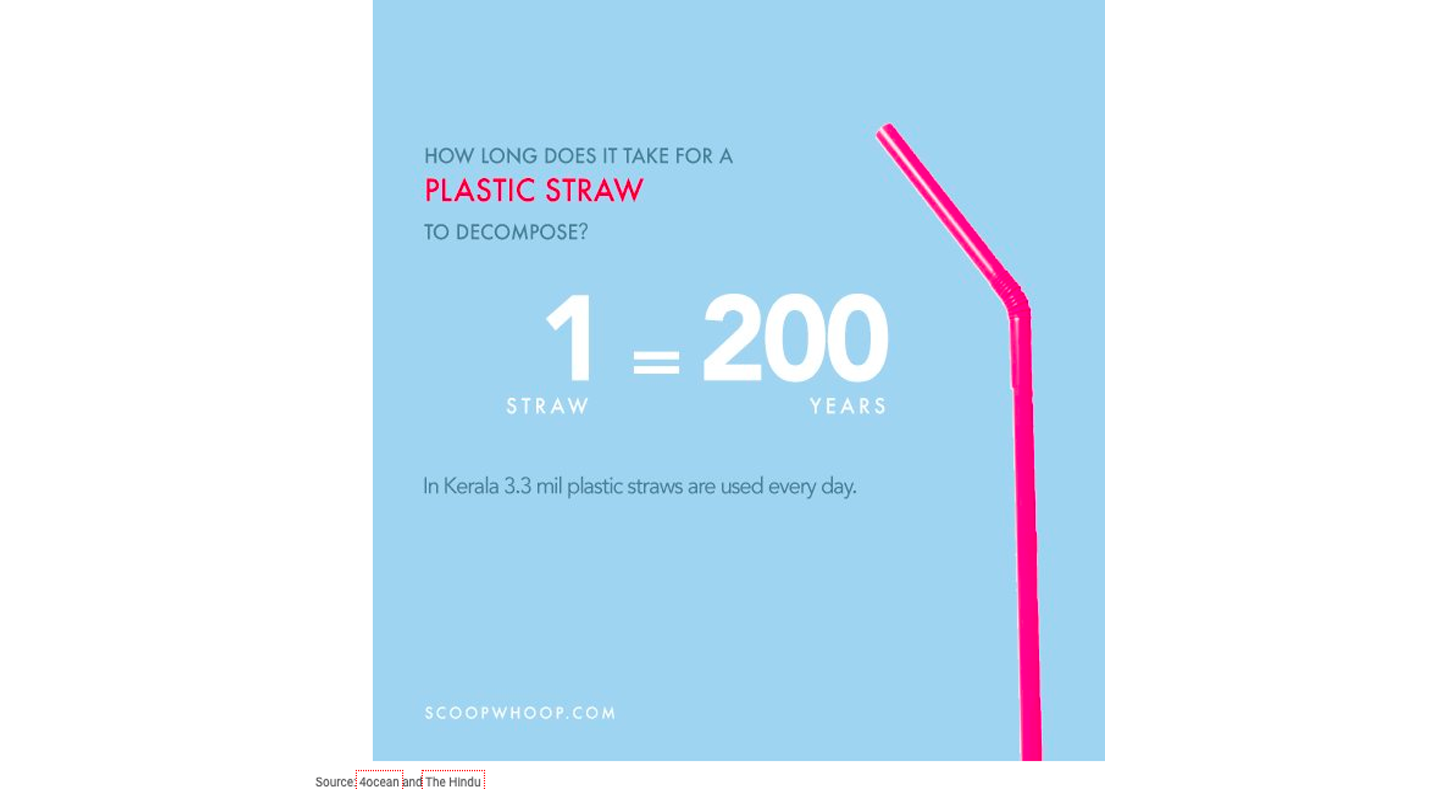
What impact does recyclable plastics having on this situation?
Scattered around this plastic world, 12 million tonnes of plastic waste and materials end up in the oceans each year moving us closer and closer to the plastic world we are trying to escape from. We need to be better.
Right now, we as Canadians recycle only 11% of all plastics with the other 89% being tossed into our landfills, oceans and or being incinerated into harmful fumes. Recyclable plastics can drastically change this statistic by removing all these harsh plastics from the environment and utilizing them to make others. If done correctly, those plastic grocery bags can be made and remade into the same bags or other plastic products instead of spending the next hundred years in a landfill or fixed to some innocent sea creature.
Plastic Alternatives: 10 Easy Options To Start Using Right Now
How To Integrate Plastic Alternatives In Our Day-To-Day Lives
Okay, so plastic is bad. But what are the alternatives? Plastic is everywhere and we need to do something to cut back on our plastic use. Easier said than done though, right?
Here’s a quick guide on what you can to do implement some plastic alternatives in your day-to-day life.
Where Can You Find Alternatives To Plastic?
There are plenty of ways you can reduce how much plastic you use by finding plastic alternatives. We’ve listed 10 options you can try, that fall under four key areas:
1. Plastic Straws
2. Plastic Bags
3. Plastic Wrap
4. Plastic Packaging
Change is good: plastic straw alternatives
Have you been to downtown Toronto recently? You might have noticed a bright orange sign as you make your walk past Union station.
A&W is at it again, but they aren’t walking around offering free teen burgers this time. The brand has displayed a 35-foot-long “Change Is Good” sculpture that is made entirely of plastic straws. 140,000 staws to be exact. This is all part of their initiative to cut back on their plastic use which will keep 82 million single-use plastic straws from ending up in landfills or bodies of water.
That figure right there is why there needs to be plastic straw alternatives. Plastics that are smaller than two inches (i.e., plastic straws) fall through the recycling sorter which is why there is such a staggering about of plastic straws that end up in oceans and landfills.
So what can we use instead?
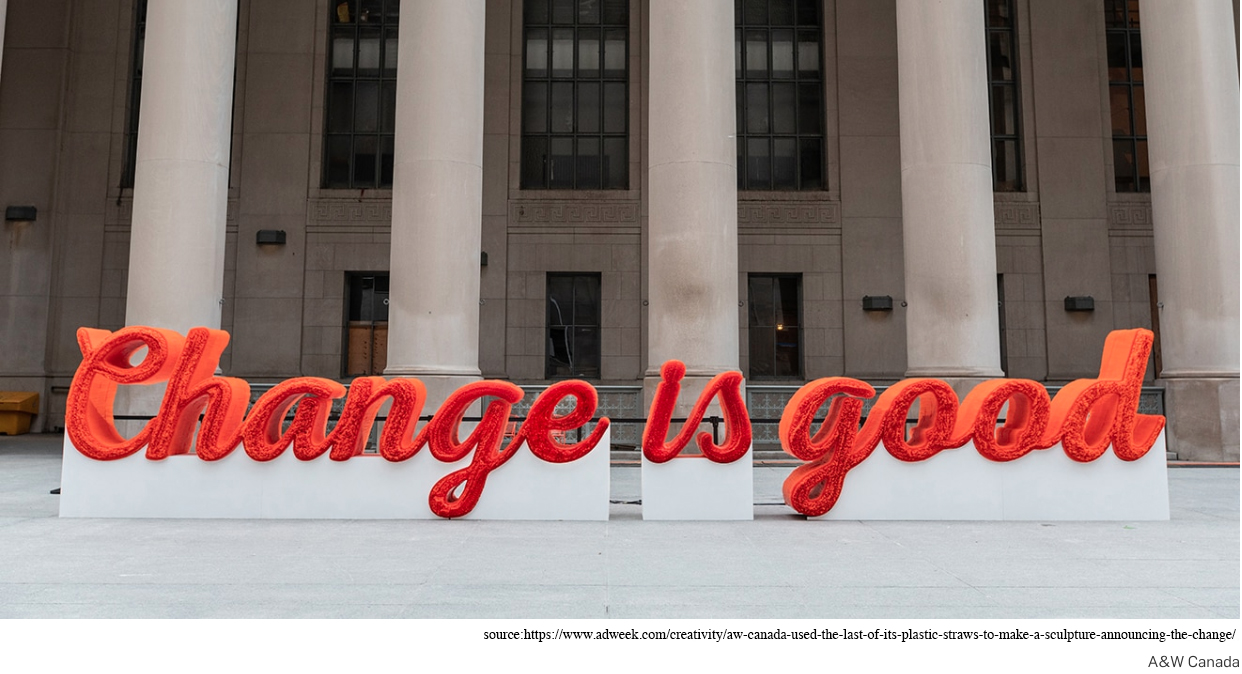
Plastic Straw Alternative 1: Paper Straws
Ah, the simple paper straw. This alternative has perhaps caused just as much controversy as to their plastic counterpart. Yes, they’re a great way to cut back on plastic use but nothing tastes the same when you’re drinking from a paper straw. And not to mention that gross soggy feeling you get when the straw has been sitting in liquid for a while – yuck!
Paper straws have proven to be an effective but not desired plastic straw alternative. When asked about which plastic straw alternative appeals to them most, only 12% of Caddle survey members indicated them as appealing.
Plastic Straw Alternative 2: Biodegradable Straws
Okay, so paper straws are a decent solution but certainly have some cons to them. What about biodegradable straws? This option could prove to be investment-worthy for both consumers and industry leaders.
Biodegradable straws are made up of polylactic acid. Doesn’t sounds to environmentally friendly, right? What if I told you this means that they’re actually made from plant starch and oil that typically comes from corn! Neat eh? What’s good about this is that since they’re made from plant materials, these straws are able to decompose naturally, thus proving to be an effective plastic alternative.
Not to mention, they look, feel, and hold just like a plastic straw would and it doesn’t get all mushy like a paper straw would.
This option of so called ‘eco-friendly plastic’ seems to be a viable one. While only 3% of Caddle survey members indicated that they use biodegradable straws, 18% of survey members indicated that this option appeals to them most.
Plastic Straw Alternative 3: Stainless steel straws
One final option in our plastic alternative arsenal is the infamous stainless steel straw. This option has hit the market in a big way. While it seems to be the most durable and mutually beneficial for the user and environment, there are certainly some drawbacks to this option.
Let’s talk about safety.
First off, sanitary safety. Stainless steel straws are a great idea to have at restaurants or have around the home, but you’re going to have to clean them after every use. We all have different degrees of cleanliness, so what might be clean to someone might not be the same to the other. So this poses an issue.
Secondly, stainless steel absorbs and retains heat. In some cases this is good. But in other cases such as this, you might really regret this purchasing decision. If your drink is scalding hot, be prepared to burn your lips. On the flip side, if you like your drinks cold, be prepared for a quick chill when you bring that straw to your mouth.
From a business standpoint, this option appears to be the most valuable. 21% of Caddle members indicated that stainless steel straws are the most appealing to them.
Plastic Straw Alternative 4: Nothing
This option is pretty self-explanatory. 😉
Alternative to Plastic Bags
How many times have you gone to the grocery store and gone to the checkout line only to remember that you left your reusable bags in the car? I know I’m guilty of it! You can either buy more reusable bags (but you already have more than you need), attempt to strategically carry your groceries without dropping them or… buy yet more plastic bags.
Earth damaging plastic: 1
Best practices to save the planet: 0
Ways to Reduce Plastic Bags
So you’re trying to cut back on your plastic bag use. You’ve got a ton of them at home, you see people using them all the time at the grocery stores, and you see plastic bags floating in the wind getting caught in trees. What do you do?
Here are some quick options:
1. If you don’t need it, say “no thanks” to the sales clerk
2. Try your best to remember to bring your reusable bag
3. Follow a recycling program that takes your plastic bags for you
4. Re-use the plastic bag, they make great lunch bags or recycle bags
Plastic Bag Alternative 1: Jute
Turns out vegetables aren’t just good for you, they’re good for the environment too! Jute is similar to that of cotton and resembles the feel and texture of hemp. This option is a cheap and easily producible option for a plastic bag alternative. When you’re done with it after several uses, throw it in the compost if you want!
Plastic Bag Alternative 2: Canvas bags
This option is certainly the most common option, and why wouldn’t it be? Canvas bags are those bags that you have probably seen at the grocery store. They make quick and easy alternatives to plastic bags. Not only are they reusable, but you can even throw them in the wash if they get a little dirty.
Side note: Don’t want to spend the money on canvas bags but have a ton of old jeans or denim skirts? Sew the bottoms of those suckers and keep the waist open, you’ve got a stylish denim bag!
Plastic Bag Alternative 3: Paper bags
Whatever happened to going grocery shopping and coming home with two huge paper bags full of groceries? I remember seeing this on TV as a kid but never got to live this fantasy, guess it was before my time. For you Ontarian readers, maybe grocery stores could take after the LCBO with their use of the paper bag?
But who’s to stay this option shouldn’t hit the market again? It’s cost-effective, environmentally friendly, and can hold a heck of a lot more than what plastic bags can.
Issues on this option scale from minor to severe. On the less severe side, paper bags are prone to be less effective if you’re carrying the bags in the rain. On the more severe side, a deforestation issue could occur due to rising production in paper products. Then we have an even worse crisis next to plastic pollution.
Alternative to Plastic Wrap
This one stumped me for a while. Plastic wrap has such a convenience to it, but what alternatives (if any) are there that can substitute using plastic wrap?
Maybe I couldn’t wrap my head around it (heh, get it?) but there are quite a few quick and easy alternatives to plastic wrap that I bet you might even have laying around your home.
First up, storage containers such as tupperware and glass jars. They’re quick, they’re simple, and everyone’s got em.
How about parchment paper or aluminum foil? The worst is when you put your food in the microwave and forget to take the plastic off and you end up turning your once edible food into a delicious looking plastic display. Although for cost purposes we don’t suggest keeping the aluminum foil on your food in the microwave. You can certainly do this with parchment paper though!
How are we Going to Cut Back on all This Plastic Packaging?
Now here’s a tough question.
Whether it be the grocery store or a tech store, a lot of our products are kept safe in plastic packaging. Let’s be honest though, we could do away with all that plastic packaging. Especially that tough stuff that takes the jaws of life to open a package – good riddance.
Alternatives to Plastic Packaging
On the consumer side, this is a pretty difficult task. We don’t wrap our products in plastic, we just buy the stuff and throw out the excess.
But finding ways to reduce plastic packaging is key. An estimated 40% of plastic produced is packaging. So this one is on you, company innovators!
One option that seems to be a common trend here is plant-based plastics. This plastic packaging alternative is a simple one that looks and feels like plastic and is easily malleable so it can be turned into any shape. But would this be an effective product packaging both food and tangible products, or just one or the other?
Zero-waste Grocery Stores
While this next option isn’t necessarily an alternative to plastic packaging itself, this idea is one that is making slow progress in the market and has the potential to grow in the industry under the right circumstances.
Zero-waste grocery stores are sparsely spread throughout Canada but offer an environmentally friendly alternative to plastic packaging.
You as a consumer would walk into the grocery store with your own packaging, whether that be tote bags or reusable containers, pick off the shelf an item you want, weigh your items at checkout and go home.
This option is a green alternative and Caddle members indicate that this might be a viable option. 30% of survey members indicated that they have no concerns with bringing their own reusable containers and bags for purchasing food at their local grocery store.
A Viable Solution to Our Plastic World
There you have it. We know that plastic is everywhere and it’s not easy to get rid of it. But there are certainly some plastic alternatives that are easy to use when you take the time and think about it.
Which plastic alternative do you think will hit the market sooner than later and have a positive impact on the environment?
[simple-author-box]
Plastic World: The True Impact of Plastic on Our Planet
Plastic World: A place we can’t seem to escape
I come in all shapes and sizes. Sometimes I’m important and other times I’m not. I’m able to live longer than any human. But most importantly, I’m harming the world.
What am I?
If you answered plastic, you’re right.
Our reliance on plastic is having huge consequences for our planet. Across the world, plastic is dumped into the ocean at a rate of 8 million tonnes per year. By 2050, experts estimate that the plastic in the ocean will outweigh the total amount of fish in the ocean.
At Caddle we’ve been taking a close look at the issue of plastic pollution. Over the course of the next while our series ‘Plastic World’ will set out the facts, shed a light on our attitudes, and spark a conversation.
So first up, how did we get to this point?
The arrival of our plastic world
How long does it take plastic to decompose?
Microorganisms and air: the perfect decomposition
The science behind natural and unnatural products
Plastic water bottles are doing more harm than good
Which plastic destiny will you choose?
So, how do we get rid of all this plastic?
The arrival of our plastic world
Though you might think that plastic came to dominate our lives from the second half of the twentieth century onwards, it dates back far longer.
Technically speaking, plastic is a type of polymer, which is made of materials made of long, repeating chains of molecules. Humans have been dated using this naturally occurring polymers since at least 1500 BC with the Olmecs in Mexico.
Plastics as we recognize them today, began to emerge in the 19th century. Then in 1907 Bakelite the first synthetic polymer made from fossil fuels appeared. Soon after came polythene, polystyrene, and nylon.
Plastic is our everyday lives
The uses for these plastics expanded rapidly. From the 1950’s onwards came consumer goods like tupperware containers or plastic drinks bottles. In many cases the switch to plastic offered key benefits – it would be easily shaped to fit the purpose, it was durable (so wouldn’t smash, but could withstand pressure) and it was cheap to produce.
Offering these benefits, plastic became a material that consumed our daily lives in one way or another. About 300 million tonnes of plastic are produced each year. It’s virtually impossible to escape no matter how hard we try.
The durability and low cost of production is a blessing and a curse. For the plastic objects that are meant to last a long time, this is great as it means that we don’t have to worry about replacing them.
On the flip side, the abundance of single-use plastic objects that we have come to depend on are suffocating the planet. It’s as if we’ve put a plastic bag over the earth’s head and it can no longer breath (we don’t suggest you try this at home)
We’ve created a situation where the harm we’ve done has gone too far and is something that the generations to come with have to deal with.
Why is plastic bad?
At the end of the day, what can be said about plastic? Well, simply put, plastic = bad.
The things that make plastic so useful make it an environmental hazard. Its durability means it takes centuries to break down. The low cost means we use a lot of it without worrying even to the point of using a plastic item once and throwing it away.
It is estimated that over 50% of those single-use products are thrown away, leading to a huge build-up of material in landfill and oceans that will not be going anywhere for a long time.
The disposal plastics has played a major role in the growth of several large areas highly concentrated with plastic, including the famous Great Pacific Garbage patch and area that some estimates suggest has swelled to 600,000 square miles.
In turn, plastic affects the environment as a whole in a grand way, not just the oceans alone. In particular, it’s the pesky microplastics that are affecting the environment.
Microplastic: Tiny but deadly
Microplastics are tiny fragments of plastic that are being carried throughout all crevasses around the world. They have been found in the most remote places from the deepest waters to some of the highest peaks.
These microplastics affect marine life as they mistake them for tiny bits of food, which ends up in our bodies as well if we eat seafood. People who eat fish are at risk of consuming 11,000 fragments of plastic each year, according to a recent Belgian study.
Whether its affecting marine life, affecting the environment or human civilization itself, plastic has become a real issue for every form of life.
Stay tuned for this blog to delve deeper into how plastic affects all things involved with the environment.
How long does it take plastic to decompose?
It wasn’t until we really started investigating on this topic that made us realize how long plastic actually takes to decompose. But you may want to think twice the next time you play beer pong. Those red solo cups could outplay you in matches far longer than your life – longer than your children’s children in fact. Certain plastic objects could take a much as a thousand years to break down.
But how do we even know how long it takes for plastic to decompose if plastic has only really been in full production for around 50 years?
Science my friend.
Microorganisms and air: the perfect decomposition storm
If science is good at anything, it’s testing things. And that’s exactly what scientists have done in order to predict how long it takes for plastic to decompose.
When testing normal things like newspapers or banana peels, the waste samples will be placed in a microbe-rich compost which is then aerated. After that, science takes a step back and nature does its thing. The microorganisms come to life and fill their bellies with the waste sample and produce carbon dioxide which serves as an indicator of degradation.
In case you’re wondering, newspapers take two to five months to decompose while banana peels take several days.
So what does that mean for plastic, how long does that take to decompose?
The science behind natural and unnatural products
Remember how science takes a step and nature does its thing when sample waste is placed in the microbe-rich compost? Well, unlike newspaper and banana peels, plastic is far from a natural product. Plastic is made from man-made polymer known as polyethylene which microorganisms don’t attribute to being food.
In order for plastic to decompose it relies on the polyethylene to photodegrade. That is attributed to when ultraviolet radiation from the sunlight starts to breakdown the polymer chains in plastic which makes it become brittle and crack. How long does that take? Science isn’t exactly sure but it suggests that it takes anywhere from 500-1,000 years for plastic to decompose.
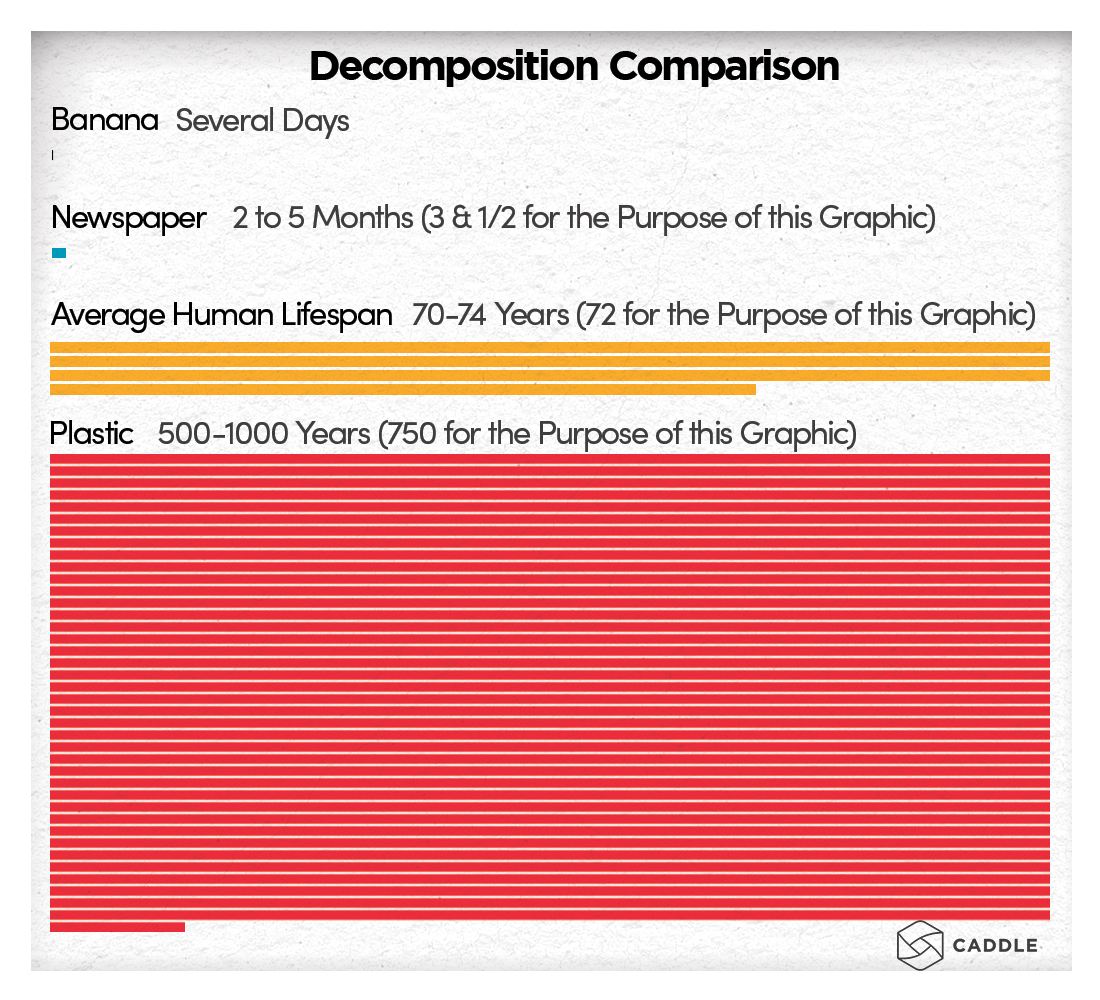
Plastic water bottles are doing more harm than good
All forms of single-use plastic are a large contributor to world pollution but when you sit down and research the effect that plastic water bottles have on the environment, the numbers are quite alarming.
With a million plastic bottles being bought around the world every minute and a 20% increased projection by 2021, plastic bottles themselves have been deemed an environmental crisis that is a large contributor to climate change reports The Guardian.
While plastic water bottles and other bottles alike, they are highly recyclable but due to the high demand that these products bring, it makes actually recycling these products very difficult which results in water bottle pollution in both landfills and the ocean.
Speaking of the ocean, roughly 7% of all recycled plastic bottles were actually turned into new bottles. Instead, between 5 million (yes million) and 13 million tonnes of plastic ends up in the ocean. With plastic bottles in the ocean, this leads to the possibility of fish mistaking the plastic bottles for food, which ends up as food that we eat. It’s the plastic circle of life! Scary, isn’t it?
While recycling plastic water bottles is an easy task since they’re highly recyclable, they’re made of a similar polyethylene product as other single-use plastics. Therefore, it’s easy to conclude that it would take roughly 500-1,000 years for a plastic water bottle to decompose.
Which plastic destiny will you choose?
Like it’s been mentioned throughout this blog, plastic is everywhere. But plastic doesn’t have to be the go-to source when it comes to everyday products that we use. Yes, some plastic alternatives might not be as ideal as others or don’t have the same ease of usability that plastic offers, but the choice is yours: save the planet from setting itself on fire or using a paper straw that makes your pop taste a little funny.
Regardless, action needs to be made for an alternative to single-use plastic products that we use and some initiatives have been set forth in order to reduce our plastic use.
So, how do we get rid of all this plastic?
Have you been to A&W lately for a classic rootbeer float or any drink that involves a straw for that matter? Their initiative to reduce and implement a plastic alternative was one that made national news. In an effort to display their decision to cut down on plastic waste, A&W Canada created a 35-foot-long “Change Is Good” sign that was made from 140,000 plastic straws that were remaining in the brand’s stockpile. By using paper straws as a plastic alternative, A&W Canada predicts that this effort will keep 82 million single-use plastic straws from ending up in landfills and bodies of water.
Plastic straws aren’t the only alternative to plastic though. Many consumer packaged goods industries have recognized the importance of finding a plastic alternative and have changed many of their products from packaging, bags, and plastic wraps.
But what about the single-use plastic that is already floating around your home? Well, you don’t necessarily have to make a huge art sculpture but there certainly are some ways DIY projects that you can do at home to find other alternatives for your plastic use.
But not every alternative is perfect. There are some products that appear to have a short term benefit but could end up hitting a roadblock later on down the road that could further contribute to environmental catastrophe.
Stay tuned for this blog to find out more.
Plastic Straws: Canada takes action
To deal with the issue of plastic, world leaders and governments are beginning to take action albeit slowly. For example, here in Canada, the Government is looking at the issue of plastic straws.
It’s fair to say that plastic straws are pretty bad for the environment. Likely you’ve seen the plastic straw being removed from the sea turtle (watch at your own discretion). Despite how alarming that video may be, it really sets the stage for why plastic straws are bad. Plastic straws are perhaps the quickest single-use plastic there is which ends up in landfills and oceans that cause harm to all forms of wildlife.
The action on plastic straws Canada plans will tackle more than just what you drink your frappuccino through.
While there is going to be an implemented single-use plastic ban which includes straws, bags, and other single-use products, this initiative won’t be legislated until 2021. That isn’t to say that Canada hasn’t made efforts to reduce plastic straws or other plastics alike. Prime Minister Justin Trudeau has encouraged leaders to sign a zero-waste plastics charter which would be an attempt to reduce plastic waste from ending up in the oceans.
Wrap up
So what is your stance on the plastic dilemma? Is this a crisis that has gone way past our capabilities of solving the problem or with the right frame of mind we can all tackle this issue and help create a greener planet?
With the help from your survey answers, further research and industry reports, these are all topics and questions that we were able to answer. We hope that it creates awareness and discussion on how we can unwrap this plastic world and let the planet breathe in some fresh air.
Research 101: Applying case study analysis for content creation
Ah, the beloved case study analysis. If you ever took business when you were in school the odds are you’ve likely heard this term before. Although, if business was mandatory or an elective for you, odds are might you either loved or hated case study analysis.
We hope it’s the latter because we’re about to dive into the topic and explain how we use its principles in our content creation. Not to worry though, you won’t be tested on this afterwards, so sit back and enjoy!
What is a case study analysis?
First of all, we should define what a case study is. According to Ashford University, a case study analysis requires you to investigate (but is not limited to) a business problem, examine alternative solutions, and propose the most effective solution using supporting evidence.
So how do we apply the principles of case study analysis to our content generation?
From case study to insights
If you’ve been following us through our blog or on social media, you’d know that we collect data in the consumer packaged goods (CPG) industry in order to accelerate our clients’ time to insights. This is where the case study principles start to come into play.
When learning how to write a case study it’s important to examine the case and determine where you want to focus your analysis on. Similarly, we do the same when we look at CPG markets.
We’ll look at markets that we believe are largely untapped, have the potential for new innovations, or investigate how new trends could influence the industry.
One way we do this by looking at our data results that our member base gives us when they answer our surveys. Once we’ve gathered this data, we’ll cross-reference these insights and see how they could provide solutions to a specific industry.
Case study, to insights, to content
Now that we have our insights gathered and we’re ready to make educated conclusions, we’ll take the principles of case study analysis and apply it to our content creation.
Introduction & Background
In this phase, we’ll set the scene with the information we know about the industry such as the market size, trends, and revenue. From there we’ll examine some problems or situations that impact the industry. For example, these may be decreased consumer spending, changing demographics or environmental impacts.
Evaluation of the case
From there we’ll see what our data provides and how our insights could benefit the industry. For example, we compared consumers who consume cannabis and drink beer. While the industry indicated consumer interest in cannabis-infused beer, our data showed that millennial males would be the best demographic to target this innovation.
Proposed solution or changes
Sometimes secondary research doesn’t show innovations or trends that an industry could benefit from. This is when we at Caddle shine! One of the goals of our survey is to find insights that suggest innovations that haven’t hit the market yet.
It’s important to ensure that these solutions are specific and realistic. Take for example half loaves of bread. Many European countries sell loaves of bread for half the size, and our survey members showed an interest in this innovation. Introducing this innovation into the North American market could help reduce food waste.
Recommendations
When finalizing our “case study” we provide suggestions for which innovation would equally benefit both the industry and the consumer. This could be through gaining brand loyalty, developing a competitive edge, or implementing environmentally friendly initiatives.
That’s a wrap
In this short little lesson, we’ve taught you how we apply case study analysis when creating content. With its principles, we’re able to compare our data to secondary research and examine how our insights suggest innovations that could benefit a market in the CPG industry.
Don’t worry about spending time using case study analysis yourself, Caddle is here to accelerate your time to insights! If you are looking for insights that could benefit your industry, fill out the form below and we’d be happy to see how we can help.
[simple-author-box]
Bone broth: what's the hype?
Caddle recently surveyed its members to understand their shopping behaviours when purchasing soup broth. An interesting finding was the interest in ready-to-drink bone broth as an innovation shoppers would be interested in purchasing. With all the hype around bone broth, we decided to dig into the industry a bit further.
Stock, Broth, Bone Broth – what’s the difference?
Good question! It all comes down to the ingredients and how long the product is cooked. Traditional broth is water simmered with vegetables, aromatics, and meat, and can include some bones. It is cooked for a short period of time—usually 45 minutes to 2 hours—then strained and seasoned. Stock is water simmered with vegetables, aromatics, and animal bones, sometimes roasted, and sometimes with some meat still attached. It is cooked for a medium period of time—usually 4 to 6 hours—then strained. Bone broth is similar to stock, but with a longer simmer time – often more than 24 hours, allowing for more nutritious minerals to be extracted
So what’s the hype on bone broth?
The emerging popularity of bone broth has been synonymous with developing health trends, education around the benefits of this product and more recently, the rise of product availability. Popular food trends such as the Whole 30, Keto and AIP diets are helping to drive the increased awareness of the supposed benefits of bone broth. While medical opinions differ on the effectiveness of the ‘bone broth diet’, some suggested benefits include:
- Reduction of Leaky Gut syndrome – linked to acne, allergies, celiac disease, depression, eczema, migraines, rosacea.
- Reduction in inflammation in the body and fighting joint health – particularly arthritis.
- Collagen – this essential nutrient is attributed to improving recovery time in sports, increasing skin elasticity for skincare benefits and reduce cellulite.
- Sports recovery and nutrition
- Animal health – in addition to humans, animals can benefit from this nutrition-rich option and bone broth soup can aid in joint recovery particularly for older animals.
Who are the current market players?
Research from Innova Market Insights looked at the top 100 sales companies in the CPG industry, particularly in food and beverage. The results show that General Mills and McCormick are the only parent companies in this category with a bone broth product in their US portfolio – both from acquisitions rather than internal innovation.
With year-over-year industry growth, the VC community has taken an interest, investing in smaller, privately held companies. Kettle and Fire, an industry competitor, started by a bone broth devotee, recently secured an $8 million Series A investment. Reporting that sales have tripled each year since inception in 2015, with 2018 sales forecasted at over $20 million. The investment will primarily go towards marketing efforts and allowing for more working capital as they haven’t been able to keep up with the product demand. Another market leader in the space, Ancient Nutrition secured $103 million in 2018 with a mix of private and investment funds, lead by VMG Partners.

What are the innovations?
While currently available bone broth is sold in powder form, insights from our research suggest that 30% of Canadians would be interested in a ready-to-drink (RTD) format. Whole Foods recently jumped on this trend when they partnered with start-up Ossa Organic to launch a pop-up ‘bone broth bar’ in one of their UK stores; introducing consumers to what is being marketed as “the new coffee”.
One of the biggest appeals for bone broth soup is the time-saving factor of purchasing RTD products. Caddle users indicated that one in three Canadians are interested in a RTD chicken bone broth. While ready-to-drink formats are a relatively new trend, bone broth is leading the interest in fortified food and beverage products in a ready-to-go availability. This indicates that combined products such as the like of drinkable bone broth will become the norm. With its ease of maintaining one’s health, this is thus driving the demand for products such as these.
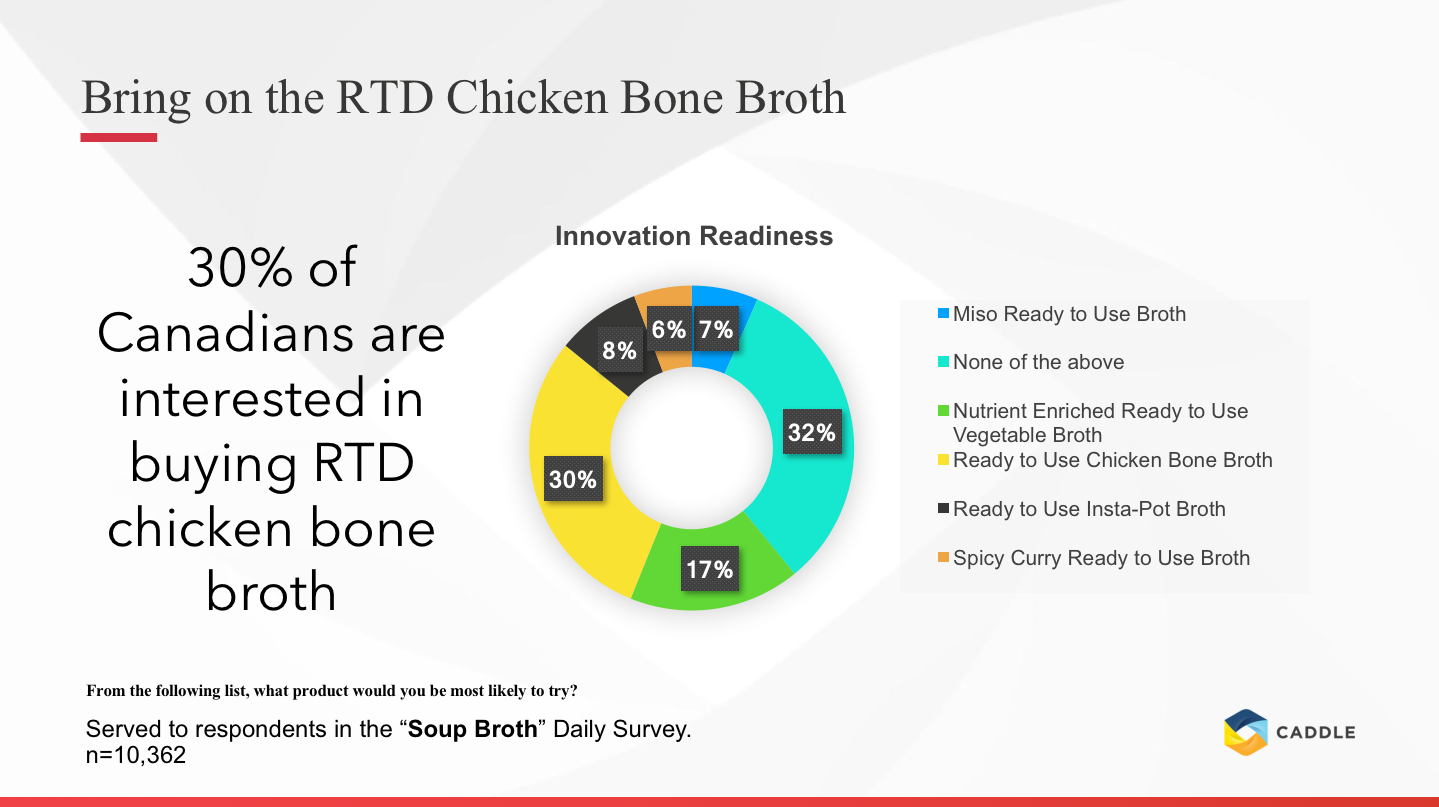
Wrapping up
With consumers being so readily concerned about their health, it appears that bone broth will become an emerging trend that will see a rise in demand in the coming years. With its many health benefits and ease of consumption, this will create an enticing opportunity for industry leaders to jump on this trend — or allow new entrants to enter the market as well.
Caddle is a consumer insights platform that allows consumer packaged goods companies to link directly to their target audience via surveys. As part of our daily survey activity, Caddle examined the decision-making process for consumers choosing their preferred brand of soup broth.
Are you launching a new product or looking to get insights before innovating? Connect with us to find out how Caddle can help.
Eat your frozen dessert cake & have it too: industry insights
Just when you thought cake couldn’t get any better, they came out with frozen dessert cakes. You knew it was going to be a great birthday when you were presented with one of them. Although those days might be long gone for some of us, it appears that we’ve passed down the tradition to younger generations.
Overall, the global frozen dessert market is forecasted to reach $228.56 billion by 2024 with a compound annual growth rate of 5.32 percent from 2019-2024, reports Mordor Intelligence. Much of the market is driven by rising disposable incomes, the introduction of new flavours, and increasing impulse purchasing habits.
In Canada alone, there were 131 frozen dessert and ice cream manufacturing establishments in 2016 in which the whole industry saw a $385 million revenue in 2018.
Here at Caddle we wanted to have our cake and eat it too. So, we sought out and asked over 8,100 survey respondents their purchasing habits when it came to frozen dessert cakes.
The cake that won’t go straight to your hips
While frozen dessert cakes are elaborate as is, this leaves little room for innovation when it comes to aesthetics. This doesn’t mean that there isn’t the opportunity at all for innovation – 52% of respondents indicated that they would be open to trying a frozen dessert cake innovation.
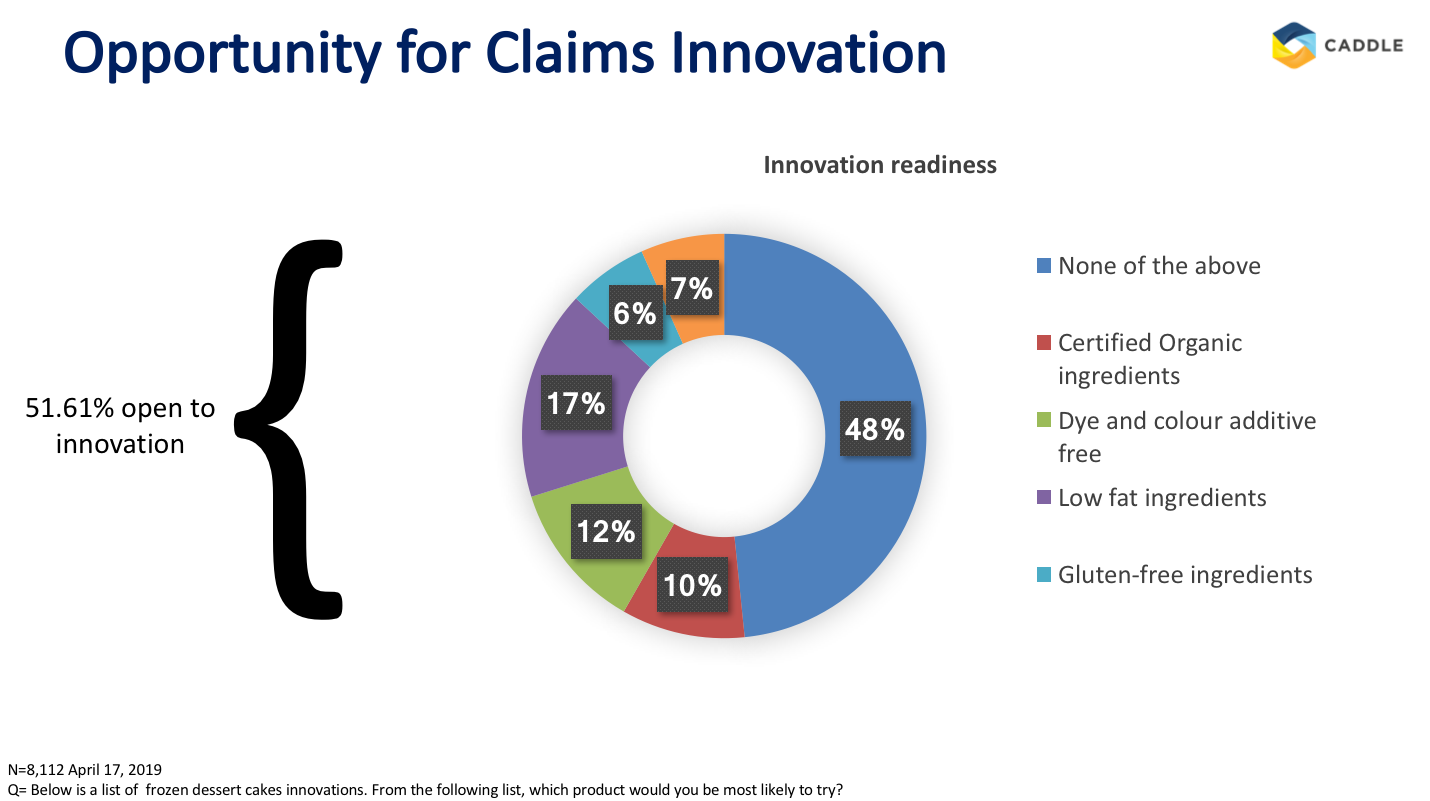
Looking toward market insights, it appears that ingredients play a large role in consumer wants when it comes to dessert. Low sugar/salt, plant-based health and nutrition have become megatrends that are driving product development across the dessert production.
Interestingly, dietary trends themselves have become a major aspect of product development. Plant-based diets along with an interest in vegan and vegetarian lifestyles have created an 11 percent compound annual growth rate from 2013-2017, as reported by Food Ingredients First
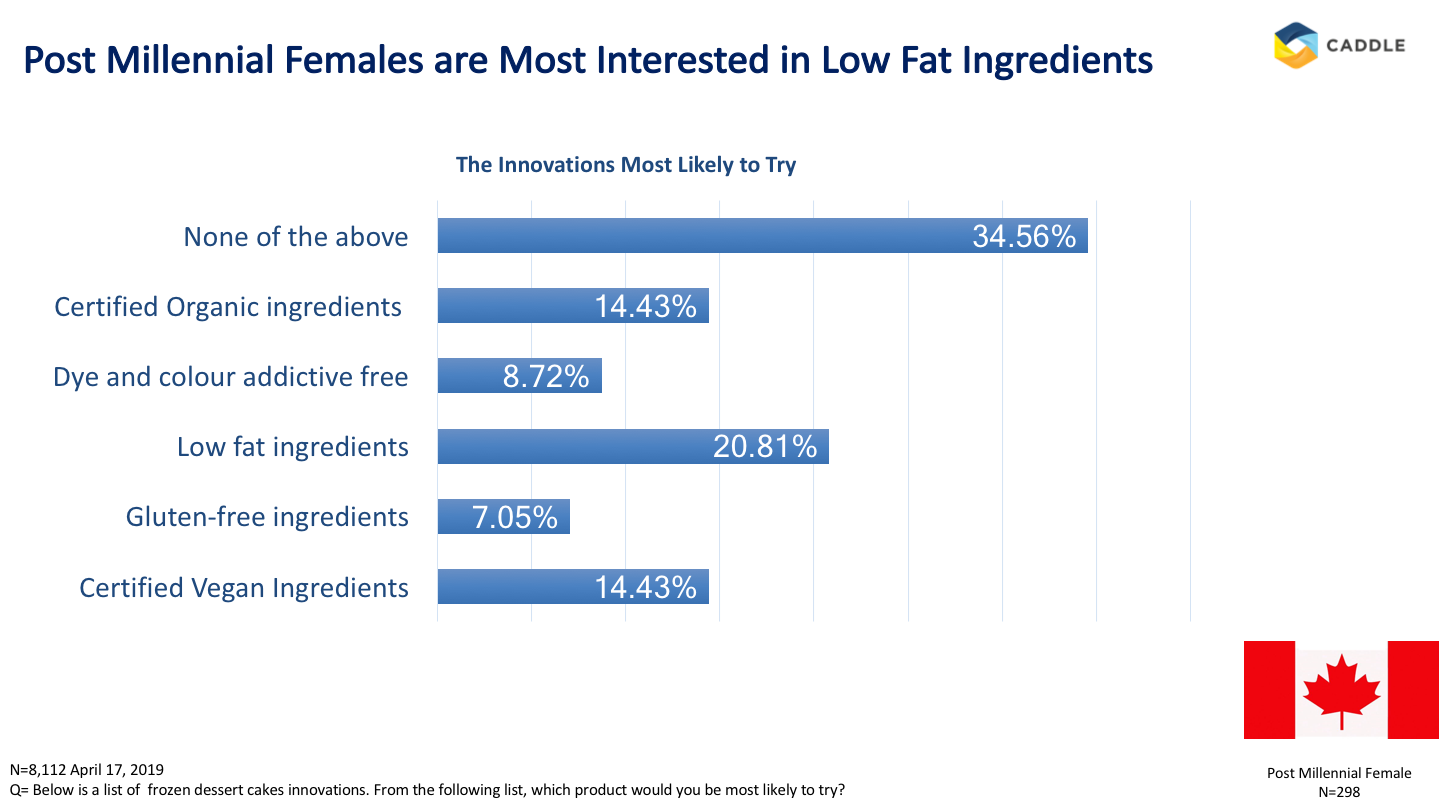
Ice cream for insights
In our survey, we asked respondents what type of innovation they would be most interested in trying and 20% of post-millennial females in Canada agreed that they would be most interested in trying a frozen dessert cake with low-fat ingredients. This is an interesting insight as ice cream — the cousin to frozen dessert cakes — have become a trendsetter with its adaptation to low-fat ingredients.
Take, for example, Halo Top which sold 3 million units since its launch, and Oppo who made more revenue in the first seven weeks of their 2018 financial year than their whole year previous, as reported by The Guardian The reason: low-fat ice cream. On top of that, Dairy Queen — a frozen dessert cake specialist — listed “focus on healthy treats proposition” as an opportunity in their SWOT analysis.
The proof is in the pudding (or ice cream in this case) that low-fat ingredients are key to market profit. Perhaps if the frozen dessert category adhered to their distant relative’s process by incorporating low-fat ice cream into their frozen dessert cakes, this would be a key innovation to profit.
I see it, I want it
When it comes to purchasing frozen dessert cakes, 47% of consumers indicated that they won’t put it on their grocery list, but will purchase it when they see it in the store. Continually, 53% of respondents indicated that price and taste are the two main purchase drivers when it comes to purchasing the sweet, frozen treat.
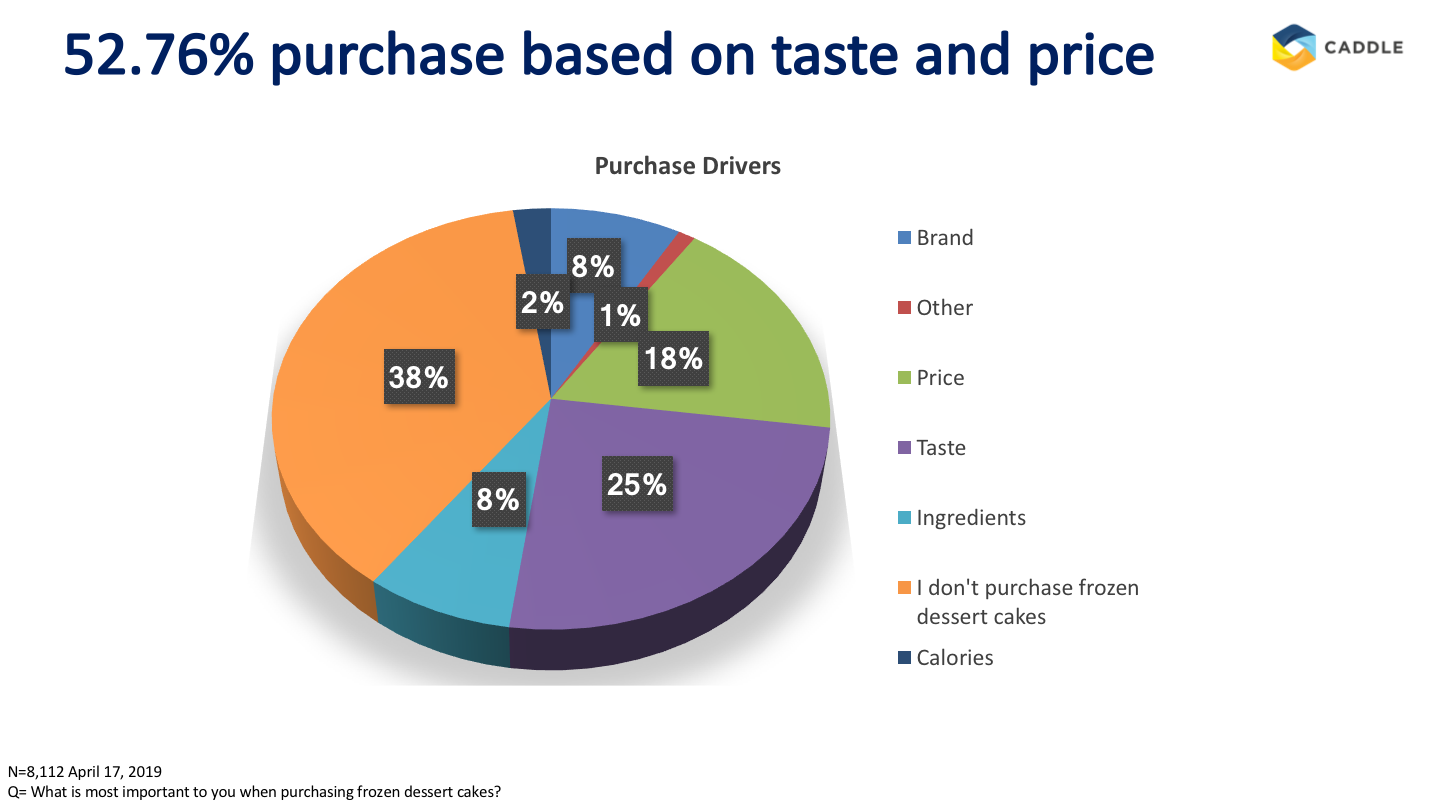
Respondents indicated that they will purchase frozen dessert cakes when they see it in the store aligns with market trends indicating that the market is growing due to increasing disposable incomes.
Further, MarketResearch.biz found that the introduction of new innovative products with different tastes and flavoured frozen desserts is expected to have a positive impact on market growth. Certainly, with respondents indicating that they purchase the sweet treat based on taste, consumers will be enticed to purchase these new flavours when they see them in their local grocery store or ice cream stand.
So what?
Frozen dessert cakes are a treat that anybody at any age can enjoy. With the increase in disposable income and health trends, it appears that consumers are looking for a sweet treat with low-fat ingredients in them. If industry leaders follow this trend, they should be certain for a path of success.
If you’re in the CGP industry and are interested in gaining insights on your consumers, we encourage you to reach out to us and see how we can transform your questions into insights.
[simple-author-box]
Oil free, cruelty free & anti-aging serum among moisturizer wants
Time and time again we hear in advertisements that moisturizer is the key to healthy, long-lasting skin. And quite frankly, they’re right! You never really realize how great moisturizer is until you’ve got uncomfortably dry skin that is begging for a little TLC.
But we all use moisturizer for different wants and needs, which is exactly why the market has such a high demand for product innovations that can tend to several different audiences. Market Research Future reports that Manufacturers have been focusing on developing unique formulations and adding it to the existing product line in order to enhance the value of their product range. Therefore, this industry is a very customer-oriented market in order to meet their needs.
With the market constantly in the battle to develop new and improved innovations and integrate them into their product lines, the industry is expected to have a calculated 5.7% compound annual growth rate during 2013-2023.
But what kind of innovations do consumers want from their moisturizer? You’re in luck, Caddle has the answers! Recently, we surveyed over 11,000 of our members on their moisturizer purchasing habits, and we were intrigued when comparing our results with industry trends. Let’s find out what we learned.
A product for any skin type
Ah, the battle of the generations. You’ve heard it before, “those darn millennials” or “those outdated baby boomers”. Believe it or not, the battle between generations has been an argument that has been passed down for generations and will continue to do so.
But maybe that’s because we all want different things? This certainly seems to be a possibility when it comes to moisturizer. When we asked our members what innovations they would be most interested in trying, each generation voted for something different. This is fluid with the industry itself as moisturizing cream has been segmented on the basis of specialty attributes. These attributes consist of:
- Natural & organic
- Herbal
- Cruelty-free
- Anti-aging
- Acne
Let’s face it, a 60-year-old baby boomer is less likely to apply acne prevention moisturizer on their face than what a 16-year-old would, and the same can be said that a 16-year-old is less likely to apply anti-aging moisturizer to their face.
The point is, each generation is going to want something different out of their moisturizer, so it’s only fair that those in the industry meet each generation’s needs. And, why wouldn’t they? More wants lead to more opportunities for innovation, which leads to new product lines, which lead to profit!
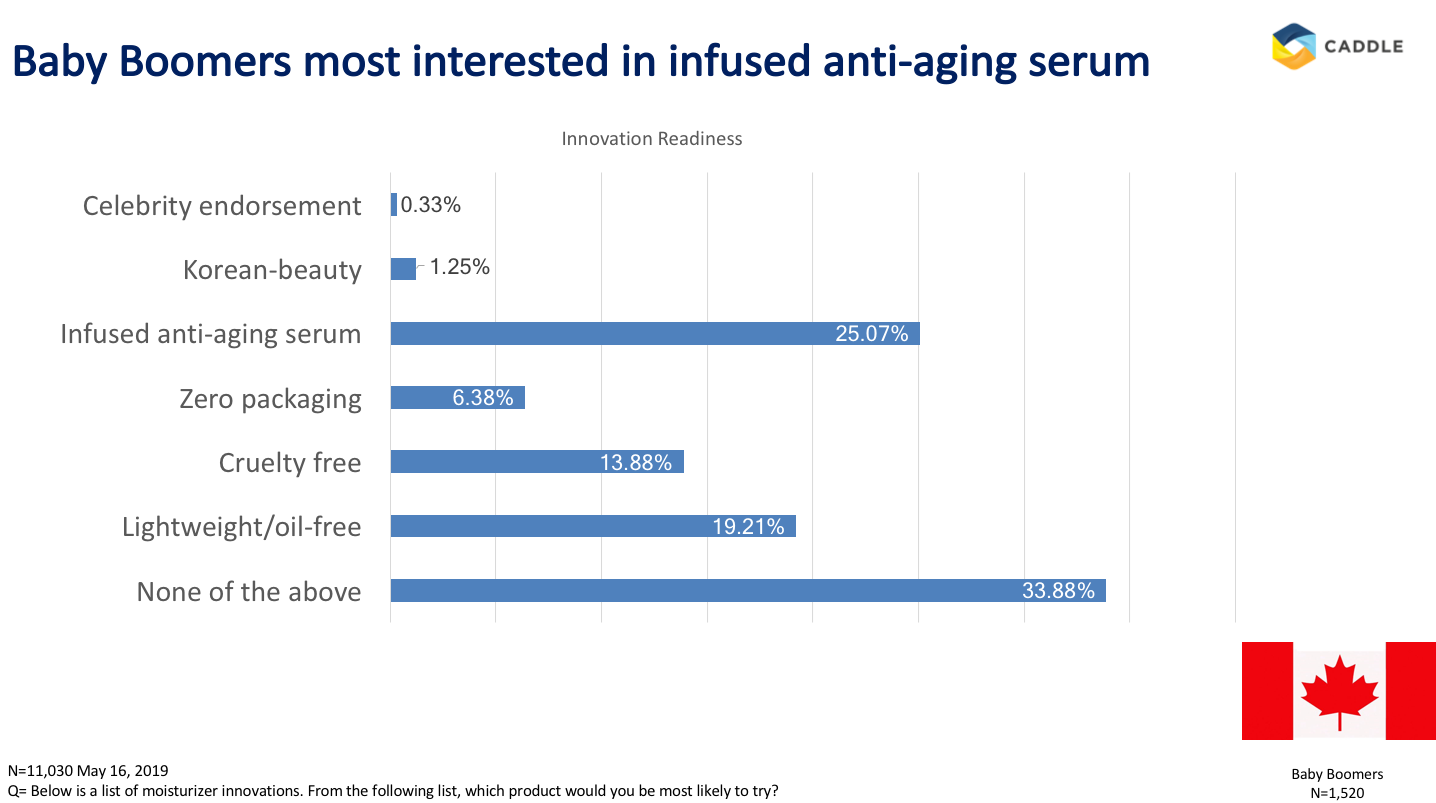
Vegan Moisturizer?
Not quite, but close! Being vegan means more than just cutting meat out of your diet, it means taking care of those little critters too. In turn, this rapidly increasing lifestyle is having a big effect on the CPG industry. In particular, “market share of cruelty-free moisturizing cream is found to be growing at a higher rate due to the rising population of vegan consumers,” noted Market Research Future.
This is something that holds true to Gen Z members. When asked what innovations they would be most interested in trying, 32% of Gen Z members indicated that they would be most interested in trying cruelty-free moisturizer. When compared to other beauty products, this seems to be a common trend. When we asked our members, what cleansing wipe innovations they would be most interested in trying, Gen Z members again indicated that they would be interested in a cruelty-free product.

It appears that veganism is a relatively new lifestyle, so where do Gen X and Millennials fit into this category? They too are following suit. While these members indicated that they would be most interested in Oil free/lightweight moisturizer, their second common innovation turned towards, — you guessed it – cruelty-free.
This creates the perfect opportunity for industry leaders to develop products that meet the needs of multiple consumers wants. Take Alba Botanica for example. Their Acnedote Oil Control Lotion is a lotion that is not only oil-free but cruelty-free too.
Certainly, creating a single product that meets the needs of multiple audiences is bound to turn a profit.

Is K-beauty the road to healthy skin?
With some products, we tend to be brand loyal beings. In the case of moisturizer, while 46% of members indicated that they would purchase a different brand of moisturizer if their preferred brand was out of stock, a surprising 21% said that they would go to a different store to find their preferred brand.
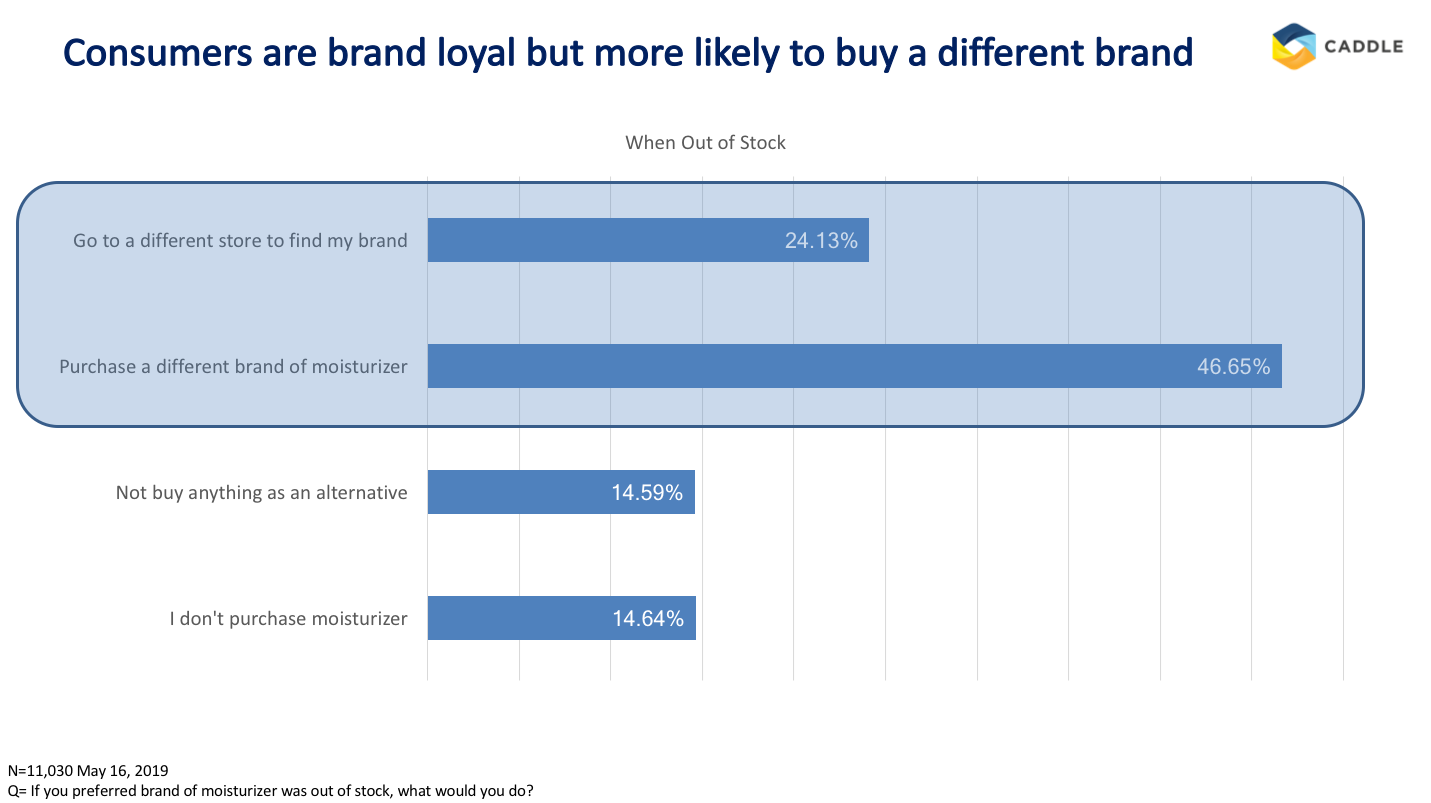
But when it comes to your face, your main concern shouldn’t be brand says beautytap.com. Skin manufacturers don’t know every skin type, let alone your own, so it’s important to be loyal to your skin’s needs and the ingredients that meet them.
“The options come directly to us by the brands themselves, which is why K-beauty (Korean beauty) stands mostly apart from the pack. You see, as a general rule, we’re pursuing them instead of the other way around,” Tracy Teel of beautytap.com mentions.
Teel makes a good point. Perhaps consumers are spending too much time being brand loyal instead of researching which brand is best for their skin. She also makes note of K-beauty. A form of beauty products that are focused on health, hydration, and naturalness.
K-beauty ranked as one of the lowest innovations that our members would be most interested in trying. Perhaps this is an untapped market that industry leaders could integrate into their product line and marketing campaigns to bring more awareness about the benefits of K-beauty.
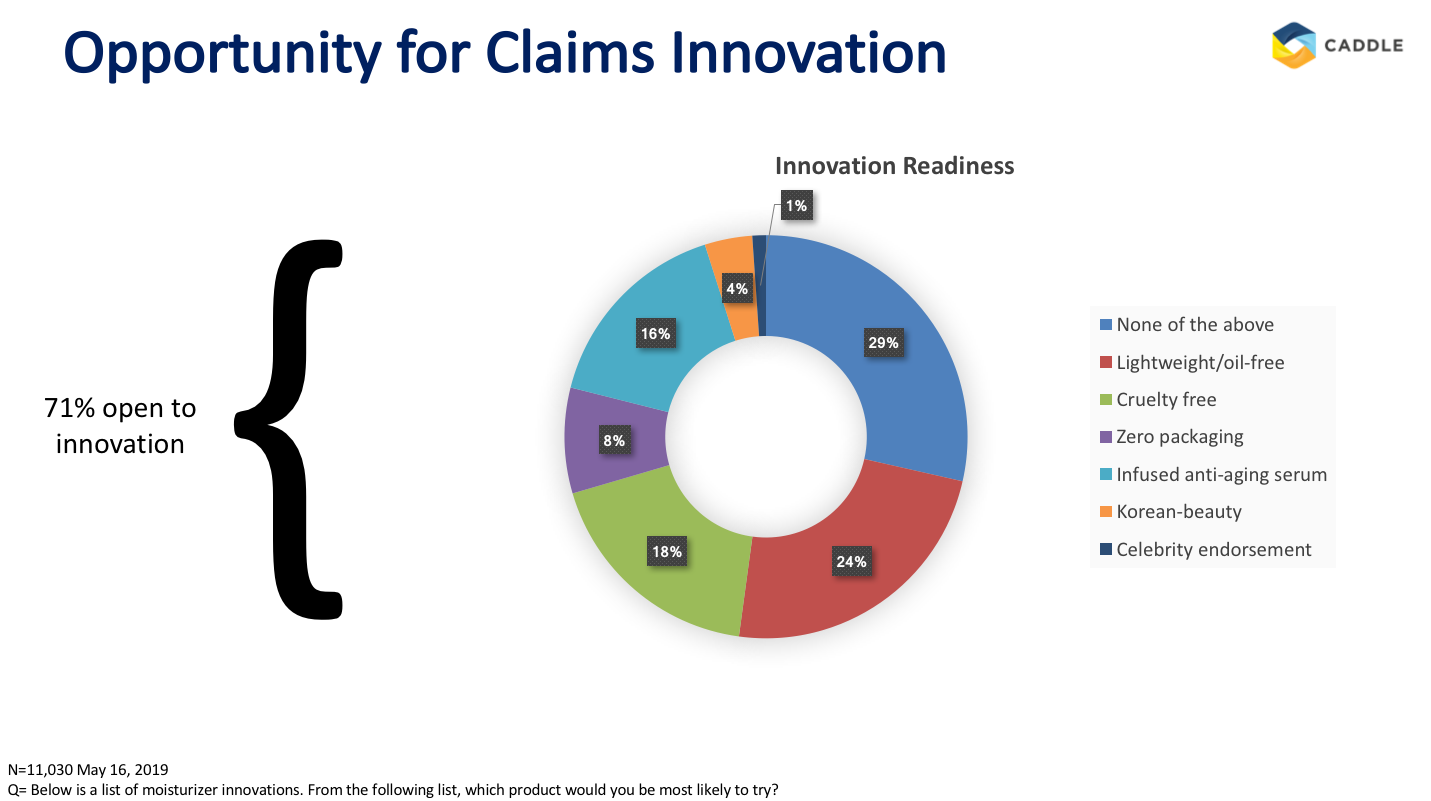
So What?
After comparing industry trends to what our members indicated in our survey, it is evident to see that the moisturizer industry is full of potential. With the opportunity to create products that tend to specific generations, or even a collective of generations in one product, or the potential marketing strategy K-beauty products could adapt, the industry is certain to see the CPAG increase as forecasted.
If you’re in the CPG industry and you’re wanting to gain insights on your consumers without lengthy wait times, please reach out to us here at Caddle so we can accelerate your time to insights.
[simple-author-box]
